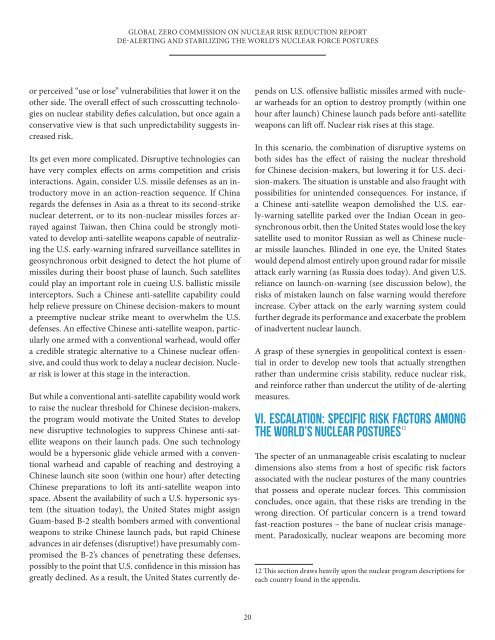global_zero_commission_on_nuclear_risk_reduction_report
global_zero_commission_on_nuclear_risk_reduction_report
global_zero_commission_on_nuclear_risk_reduction_report
Create successful ePaper yourself
Turn your PDF publications into a flip-book with our unique Google optimized e-Paper software.
GLOBAL ZERO COMMISSION ON NUCLEAR RISK REDUCTION REPORTDE-ALERTING AND STABILIZING THE WORLD’S NUCLEAR FORCE POSTURESor perceived “use or lose” vulnerabilities that lower it <strong>on</strong> theother side. The overall effect of such crosscutting technologies<strong>on</strong> <strong>nuclear</strong> stability defies calculati<strong>on</strong>, but <strong>on</strong>ce again ac<strong>on</strong>servative view is that such unpredictability suggests increased<strong>risk</strong>.Its get even more complicated. Disruptive technologies canhave very complex effects <strong>on</strong> arms competiti<strong>on</strong> and crisisinteracti<strong>on</strong>s. Again, c<strong>on</strong>sider U.S. missile defenses as an introductorymove in an acti<strong>on</strong>-reacti<strong>on</strong> sequence. If Chinaregards the defenses in Asia as a threat to its sec<strong>on</strong>d-strike<strong>nuclear</strong> deterrent, or to its n<strong>on</strong>-<strong>nuclear</strong> missiles forces arrayedagainst Taiwan, then China could be str<strong>on</strong>gly motivatedto develop anti-satellite weap<strong>on</strong>s capable of neutralizingthe U.S. early-warning infrared surveillance satellites ingeosynchr<strong>on</strong>ous orbit designed to detect the hot plume ofmissiles during their boost phase of launch. Such satellitescould play an important role in cueing U.S. ballistic missileinterceptors. Such a Chinese anti-satellite capability couldhelp relieve pressure <strong>on</strong> Chinese decisi<strong>on</strong>-makers to mounta preemptive <strong>nuclear</strong> strike meant to overwhelm the U.S.defenses. An effective Chinese anti-satellite weap<strong>on</strong>, particularly<strong>on</strong>e armed with a c<strong>on</strong>venti<strong>on</strong>al warhead, would offera credible strategic alternative to a Chinese <strong>nuclear</strong> offensive,and could thus work to delay a <strong>nuclear</strong> decisi<strong>on</strong>. Nuclear<strong>risk</strong> is lower at this stage in the interacti<strong>on</strong>.But while a c<strong>on</strong>venti<strong>on</strong>al anti-satellite capability would workto raise the <strong>nuclear</strong> threshold for Chinese decisi<strong>on</strong>-makers,the program would motivate the United States to developnew disruptive technologies to suppress Chinese anti-satelliteweap<strong>on</strong>s <strong>on</strong> their launch pads. One such technologywould be a hypers<strong>on</strong>ic glide vehicle armed with a c<strong>on</strong>venti<strong>on</strong>alwarhead and capable of reaching and destroying aChinese launch site so<strong>on</strong> (within <strong>on</strong>e hour) after detectingChinese preparati<strong>on</strong>s to loft its anti-satellite weap<strong>on</strong> intospace. Absent the availability of such a U.S. hypers<strong>on</strong>ic system(the situati<strong>on</strong> today), the United States might assignGuam-based B-2 stealth bombers armed with c<strong>on</strong>venti<strong>on</strong>alweap<strong>on</strong>s to strike Chinese launch pads, but rapid Chineseadvances in air defenses (disruptive!) have presumably compromisedthe B-2’s chances of penetrating these defenses,possibly to the point that U.S. c<strong>on</strong>fidence in this missi<strong>on</strong> hasgreatly declined. As a result, the United States currently depends<strong>on</strong> U.S. offensive ballistic missiles armed with <strong>nuclear</strong>warheads for an opti<strong>on</strong> to destroy promptly (within <strong>on</strong>ehour after launch) Chinese launch pads before anti-satelliteweap<strong>on</strong>s can lift off. Nuclear <strong>risk</strong> rises at this stage.In this scenario, the combinati<strong>on</strong> of disruptive systems <strong>on</strong>both sides has the effect of raising the <strong>nuclear</strong> thresholdfor Chinese decisi<strong>on</strong>-makers, but lowering it for U.S. decisi<strong>on</strong>-makers.The situati<strong>on</strong> is unstable and also fraught withpossibilities for unintended c<strong>on</strong>sequences. For instance, ifa Chinese anti-satellite weap<strong>on</strong> demolished the U.S. early-warningsatellite parked over the Indian Ocean in geosynchr<strong>on</strong>ousorbit, then the United States would lose the keysatellite used to m<strong>on</strong>itor Russian as well as Chinese <strong>nuclear</strong>missile launches. Blinded in <strong>on</strong>e eye, the United Stateswould depend almost entirely up<strong>on</strong> ground radar for missileattack early warning (as Russia does today). And given U.S.reliance <strong>on</strong> launch-<strong>on</strong>-warning (see discussi<strong>on</strong> below), the<strong>risk</strong>s of mistaken launch <strong>on</strong> false warning would thereforeincrease. Cyber attack <strong>on</strong> the early warning system couldfurther degrade its performance and exacerbate the problemof inadvertent <strong>nuclear</strong> launch.A grasp of these synergies in geopolitical c<strong>on</strong>text is essentialin order to develop new tools that actually strengthenrather than undermine crisis stability, reduce <strong>nuclear</strong> <strong>risk</strong>,and reinforce rather than undercut the utility of de-alertingmeasures.VI. ESCALATION: SPECIFIC RISK FACTORS AMONGTHE WORLD’S NUCLEAR POSTURES 12The specter of an unmanageable crisis escalating to <strong>nuclear</strong>dimensi<strong>on</strong>s also stems from a host of specific <strong>risk</strong> factorsassociated with the <strong>nuclear</strong> postures of the many countriesthat possess and operate <strong>nuclear</strong> forces. This <str<strong>on</strong>g>commissi<strong>on</strong></str<strong>on</strong>g>c<strong>on</strong>cludes, <strong>on</strong>ce again, that these <strong>risk</strong>s are trending in thewr<strong>on</strong>g directi<strong>on</strong>. Of particular c<strong>on</strong>cern is a trend towardfast-reacti<strong>on</strong> postures – the bane of <strong>nuclear</strong> crisis management.Paradoxically, <strong>nuclear</strong> weap<strong>on</strong>s are becoming more12 This secti<strong>on</strong> draws heavily up<strong>on</strong> the <strong>nuclear</strong> program descripti<strong>on</strong>s foreach country found in the appendix.20


